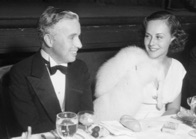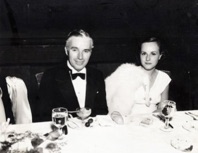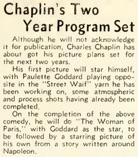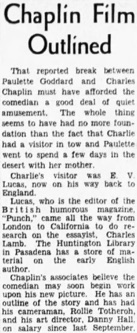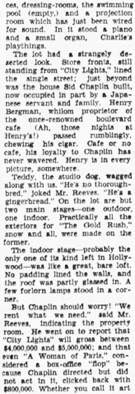Modern Times 1935 1936 1937 next previous
Modern Times Clippings 85/382
Motion Picture Herald, New York, April 14, 1934.
Charles Chaplin with Paulette Goddard at a dinner honoring
Walt Disney, 1933, Discovering Chaplin
& Charles Chaplin with Paulette Goddard at a dinner honoring
Walt Disney, 1933, Discovering Chaplin
& Chaplin Film Outlined
That reported break between Paulette Goddard and
Charles Chaplin must have afforded the comedian
a good deal of quiet amusement. The whole thing seems
to have had no more foundation than the fact that
Charlie had a visitor in tow and Paulette went to spend a few
days in the desert with her mother.
Charlie‘s visitor was E. V. Lucas, now on his way back
to England.
Lucas, who is the editor of the British humorous magazine
„Punch,“ came all the way from London to California
to do research on the essayist, Charles Lamb. The Huntington
Library in Pasadena has a store of material on the
early English author.
Chapin‘s associates believe the comedian may soon
begin work upon his new picture. He has an outline
of the story and has had his cameraman, Rollie Totheroh,
and his art director, Danny Hall, on salary since
last September.
(...) Pittsburgh Sun-Telegraph, Pittsburgh, Pa.,
April 12, 1934
& Chaplin‘s Two Year Program Set
Although he will not acknowledge it for publication,
Charles Chaplin has about got his picture plans set for the
next two years.
His first picture will star himself, with Paulette
Goddard playing opposite in the „Street Waif“ yarn he has been
working on, some atmospheric and process shots
having already been completed.
(...) Hollywood Reporter, April 7, 1934
& Chaplin‘s Plans Definite
Hollywood, April 9. – Charles Chaplin today told Motion
Picture Daily he has definite intentions of having a new
feature, first since „City Lights,“ ready by fall. Chaplin will write
and adapt himself.
(...) Motion Picture Daily, April 10, 1934
& Chaplin Plans Another
Charles Chaplin declared in Hollywood this week he has
definite intentions of producing a new feature, which
he will write and adapt himself. His last was „City Lights.“
(...) Motion Picture Herald, April 14, 1934
„The lot had a strangely deserted look“
Editorial content. „A Town Called
Hollywood
BY PHILIP K. SCHEUER
CHARLES CHAPLIN IS dusting off the derby, baggy
pants and cane. In a month, he will start building
sets. His new picture, untitled, will have no dialogue. It will
be ,shot‘ from a more complete script than other
Chaplin cinemas have been. It will follow the established
pattern of his comedies, and Paulette Goddard will
appear opposite him, probably as a street waif. The couple
will not marry before production begins, and maybe
afterward.
These signs of spring were made manifest during my first
visit to the row of one-story English cottages which
comprise the Charlie Chaplin studio on La Brea. Mr. Chaplin
was nowhere in sight; but Mr. Alf Reeves, his publicist
and manager, was.
MR. REEVES HAS BEEN in sight a long time. He played
here with his own troupe in 1906, and also in the one
theater left standing in San Francisco after the fire, the same
year. In 1907 he was approached by a brisk stranger
who offered to transfer Alf Reeves and his company of twelve,
count ‘em, people to the moving picture screen, intact
with their revue, A Night in the Slums of London. Mr. Reeves,
who was under contract to Hammerstein‘s, was obliged
to refuse; he often wonders what would have happened if he
hadn‘t.
Chaplin wasn‘t with him then. He came over with Reeves
in 1910, taking the place vacated by Reeve‘s brother
Billy. The revue had a new title, A Night in an English Music
Hall. When Chaplin left him to go with Mack Sennett,
Reeves returned to England. Their association was renewed
when Reeves came back in 1918. The present studio
had just been erected.
TWELVE PICTURES HAVE been made there – the last,
City Lights, in 1931. Mr Reeves took me around,
pointing out offices, dressing-rooms, the swimming pool
(empty,) and a projection room which has just been
wired for sound. In it stood a piano and a small organ,
Charlie‘s playthings.
The lot had a strangely deserted look. Store fronts, still
standing from City Lights, lined the single street; just
beyond was the house Sid Chaplin built, now occupied in part
by a Japanese servant and family. Henry Bergman,
whilom proprietor of the once-renowned boulevard cafe (Ah,
those nights at Henry‘s!) passed rumblingly, chewing
his cigar. Cafe or no cafe, his loyalty to Chaplin has never
wavered. Henry is in every picture, somewhere.
Teddy, the studio dog, wagged along with us. ,He‘s no
thoroughbred,‘ joked Mr. Reeves. ,He‘s a gingerbred.‘
On the lot are but two main stages – one outdoor, one indoor.
Practically all the exteriors for The Gold Rush, snow
and all, were made on the former.
The indoor stage – probably the only one of its kind left
in Hollywood – was like a great, bare loft. No padding
lined the walls, and the roof was partly glassed in. A few
forlorn lamps stood in a corner.
But Chaplin should worry! ,We rent what we need,‘ said
Mr. Reeves, indicating the property room. He went
on to report that City Lights will gross between $4,000,000
and 45,000,000; and that even A Woman of Paris,
considered a box-office ,flop‘ because Chaplin directed
but did not act in it, clicked back with $800,000.
Whether you call it art or just good, clean fun, pantomime
pays.“
Redaktioneller Inhalt
Modern Times 1935 1936 1937 next previous



